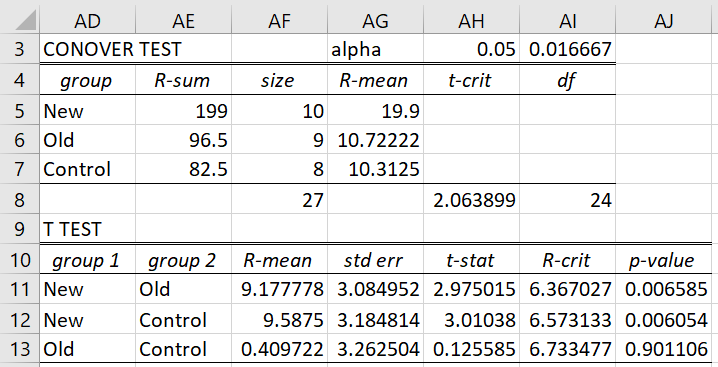Basic Concepts
The Conover test uses the following test statistic where k = the number of groups, n = the total sample size, and ni and nj are the sizes of the groups being compared.
and the standard error is
where
and rij is the rank of the ith element in the jth group.
In the above, the ties corrected version H′ can be used instead of H.
Property 1: If there are no ties, then
Proof: First note that
This last equality follows from the proof of Property 2 of the Wilcoxon Rank-Sum Test. Thus
Example
Example 1: Find all significant differences between the blemish creams of Example 1 of Kruskal-Wallis at the 95% significant level by using the Conover Test.
To perform this test, we proceed as in Example 1 of Nemenyi Test, except that we choose the Conover option instead of the Nemenyi option. When we press the OK button the result shown in Figure 1 is displayed.
Figure 1 – Conover test
If we don’t use a familywise correction, then once again New-Old and New-Control are significant. If a Bonferroni correction is used, then these same comparisons are significant (e.g. p-value = 0.006585 < .016667 = corrected alpha for New-Old comparison).
The formulas are as for Dunn’s test with a few differences. E.g. t-crit = T.INV.2T(AH3,AI8) and df = AF8-COUNT(AF5:AF7). For New-Old, t-stat = AF11/AG11, R-crit = AG11*AH$8, p-value = T.DIST.2T(AH11,AI$8) and std err is calculated by the formula
=SQRT((SUMSQ(RANKS($B$4:$D$13,1))-AF$8/4*(AF$8+1)^2)/(AF$8-1)*(AF$8-1-KRUSKAL($B$4:$D$13))/(AF$8-COUNT(AF$5:AF$7))*(1/AF5+1/AF6))
Note that the formulas for t-crit and R-crit use the uncorrected alpha value in cell AH3. To use the corrected value, you only need to replace AH3 with AI3 in the formula for t-crit in cell AH8.
References
NCSS (2018) One-way analysis of variance
https://www.ncss.com/wp-content/themes/ncss/pdf/Procedures/NCSS/One-Way_Analysis_of_Variance.pdf







